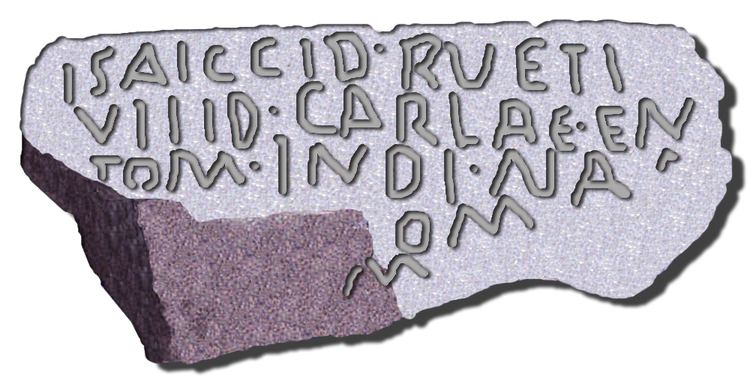Extinct 2nd century AD Linguist list xls | ISO 639-3 xls | |
 | ||
Region Beira Alta, Beira Baixa and Alto Alentejo Portugal and Extremadura and part of province of Salamanca Spain Language family Indo-EuropeanItalic (?) Para-Celtic (?) Lusitanian | ||
Lusitanian (so named after the Lusitani or Lusitanians) was a Paleohispanic language that apparently belonged to the Indo-European family. There has been support for either a connection with the ancient Italic languages or Celtic languages. It is known from only five sizeable inscriptions, dated from circa 1 CE, and numerous names of places (toponyms) and of gods (theonyms). The language was spoken in the territory inhabited by Lusitanian tribes, from the Douro to the Tagus rivers, territory that nowadays falls in Portugal, and Western Spain.
Contents
Classification and related languages
Lusitanian is an Indo-European language but it was quite different from the Celtiberian languages of the Iberian Peninsula. It is not considered a Celtic language under existing definitions of linguistic Celticity. The Lusitanian inscriptions retain Indo-European p in positions where Celtic languages would not, most unambiguously in PORCOM 'pig' in one inscription, PORGOM in another, a feature considered non-Celtic. Prósper, in her Lusitanian etymologies (2002; 2008), demonstrates that not only does Lusitanian not agree closely with the usual Celtic reflexes but that it is closer to Italic, in which case there were two well-differentiated branches of Indo-European in the Iberian Peninsula before the Romans, with Lusitanian belonging to the non-Celtic branch. Villar and Pedrero (2001) connect Lusitanian with the Italic languages. They base their finding on parallels in the names of deities and some lexical items, such as the Umbrian gomia, Lusitanian comaiam, and some grammatical elements. Prósper also sees Lusitanian as predating the introduction of Celtic and shows that it retains elements of Old European, making its origins possibly even older.
On the other hand, Koch says there is no unambiguous example of the reflexes of the Indo-European syllabic resonants *l̥, *r̥, *m̥, *n̥ and the voiced aspirate stops *bʱ, *dʱ, *ɡʱ. Additionally, names in the inscriptions can be read as Celtic, such as AMBATVS, CAELOBRIGOI and VENDICVS. Dagmar Wodtko argues that it is hard to identify Lusitanian personal or place-names that are without question not Celtic. Some argue that the p- in PORCOM does not alone mark Lusitanian as not Celtic, and that it could be classed as a Celtic dialect, but one that preserved Indo-European *p (or possibly an already phonetically weakened [ɸ], written P as an archaism). This is based largely on numerous apparently Celtic personal, deity, and place names.
Lusitanian possibly shows /p/ from Indo-European *kʷ in PVMPI, pronominal PVPPID from *kʷodkʷid, and PETRANIOI derived from *kʷetwor- 'four', but this is a feature found in many Indo-European languages from various branches (including P-Celtic), and by itself has no bearing on the question of whether Lusitanian is Celtic. Bua Carballo even suggests that pairings on different inscriptions such as Proeneiaeco and Proinei versus Broeneiae and Lapoena versus Laboena may cast doubt on the presence of a P sound in Lusitanian.
Geographical distribution
Inscriptions have been found in Arroyo de la Luz (in Cáceres), Cabeço das Fragas (in Guarda) and in Moledo (Viseu) and most recently in Ribeira da Venda. Taking into account Lusitanian theonyms, anthroponyms and toponyms, the Lusitanian sphere would include modern northeastern Portugal and adjacent areas in Spain, with the centre in Serra da Estrela.
The most famous inscriptions are those from Cabeço das Fráguas and Lamas de Moledo in Portugal and Arroyo de la Luz in Spain. Ribeira da Venda is the most recently discovered (2008).
Writing system
All the known inscriptions are written in the Latin alphabet. It is difficult to determine if the letters have a different pronunciation than the Latin values, but the frequent alternations of c with g (porcom vs. porgom) and t with d (ifadem vs. ifate), and the frequent loss of g between vowels points to a lenis pronunciation compared to Latin. In particular, between vowels and after r, b may have represented the sound /β/, and correspondingly g was written for /ɣ/, and d for /ð/.
